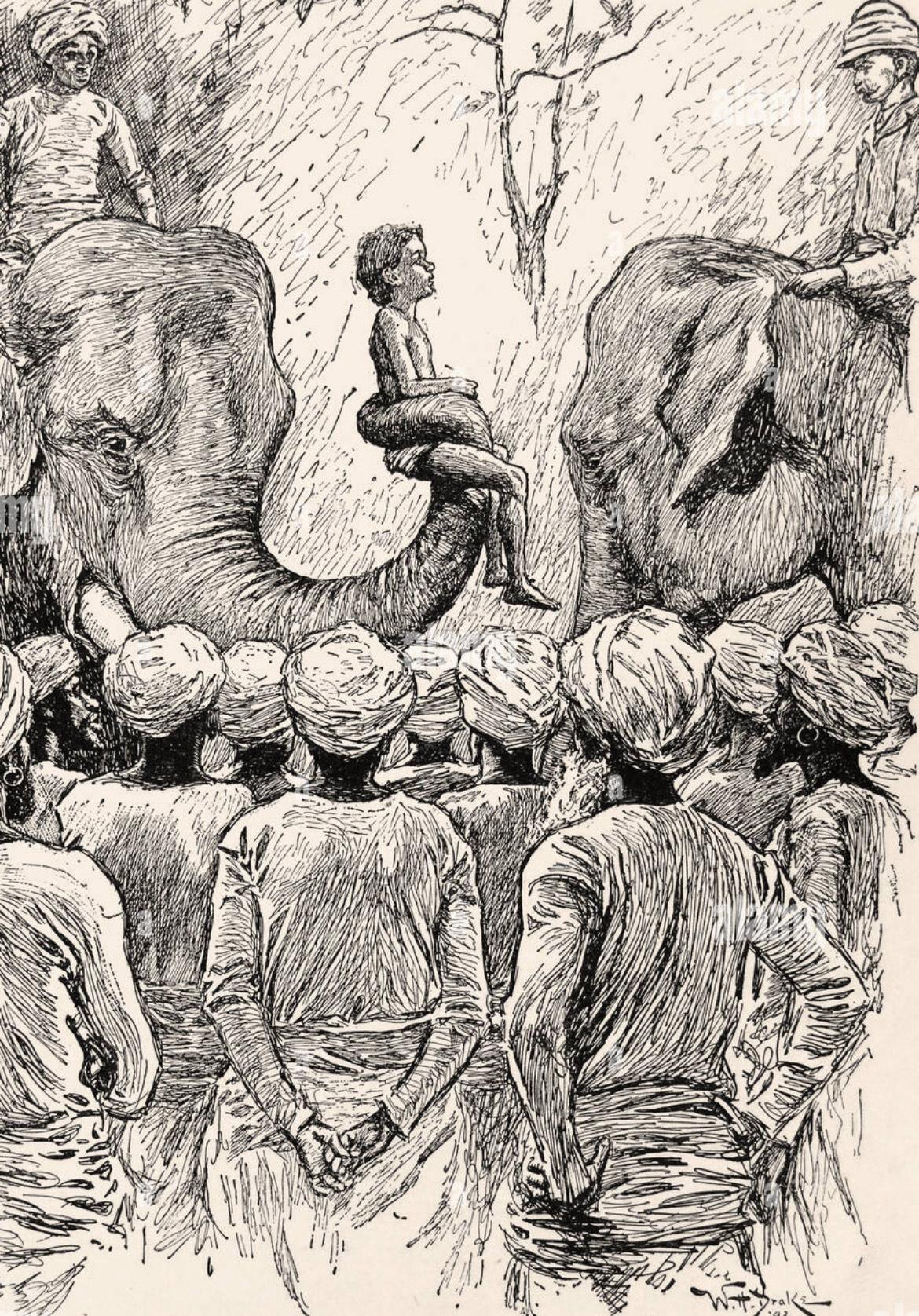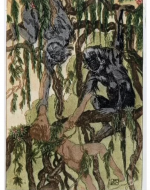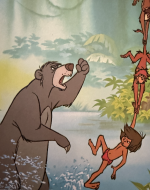Created by Katherine Manaresi on Tue, 10/15/2024 - 11:09
Description:
Rudyard Kipling’s The Jungle Book is a layered work telling the story of Mowgli, a "man-cub" raised by wolves in the Seeonee jungle, guided by a set of rules he refers to as the "Law of the Jungle." Published in 1894, Kipling's tales capture the allure of the jungle while subtly reflecting the colonial dynamics of British-occupied India. The main characters--Shere Khan, Baloo, and Bagheera--are anthropomorphized, often hinting at the cultural and racial tensions between the British and the Indian populace in the late 1800s. Kipling's life—born in India but sent to England for schooling—echoes in the themes of isolation and belonging that Mowgli experiences, which have sparked intrigue among readers for generations.
Illustrators have continued to reimagine and interpret these stories creating a timeless tale. The original edition features images drawn by W.H. Drake and Kipling’s father, John Lockwood Kipling, whose artistic style underscores the story’s mystique and serious nature. However, in contrast, Walt Disney's 1967 adaptation transformed the narrative, simplifying characters to fit more playful, silly and child-friendly archetypes. Yet, Disney's choices sparked criticism, as King Louie and his monkey tribe were argued as caricatures echoing racial stereotypes prevalent in American media at the time. This shift in portrayal softened Kipling’s complex jungle laws into a colorful adventure tale, losing some of the story’s cultural commentary and political subtext. Kipling’s work and reputation has since been re-evaluated; though celebrated for his literary expertise, he is also critiqued as a proponent of colonial ideologies. Even today, The Jungle Book prompts discussion on the power dynamics, racial tensions, and moral questions embedded within stories we often think of as simply for children. As an intricate and influential work, spurring ongoing dialogue about cultural representation and moral storytelling in children's literature, The Jungle Book remains questionable because it is a political allegory.
H. Drake, "Not Green Corn, Protector of the Poor, --Melons," said Little Toomai, from The Jungle Book, by Rudyard Kipling, 1894, MacMillan & Co first edition. Rudyard Kipling’s The Jungle Book, is a collection of stories published in 1894 that personify a variety of jungle animals– Shere Khan the tiger, Baloo the bear, and a boy or “man-cub” named Mowgli, who is raised by wolves in Seeonee, India. For much of the nineteenth century, the British controlled a large portion of India through the East India Company, which eventually turned into a direct ruling called the British Raj in the mid to late 19th century. Great tensions arose between the native people of India and the British colonizers, bringing about stereotypes of savagery and disobedience. It is thought that Kipling’s children's book reflects these intricacies, masking the impositions of British imperialism on the native people within a fictitious story. The reader also follows the theme of abandonment thought to echo Kipling’s own childhood. Rudyard Kipling was born in India and raised there for his early years. He was later sent to live with a foster family in England in the 1870s prior to attending boarding school. While the novel is less about the Darwinian struggle to survive that is typically found in person-creature relationship stories, it instead highlights serious and silly human mannerisms through animals. Nodding to the didactic tradition, Kipling uses his animal leaders to teach Mowgli and, in turn, the reader to respect and obey authority and know his place in the jungle as Mowgli searches for belonging and forges his identity. The story has been published in various early editions with others illustrated by Rudyard Kipling's father: John Lockwood Kipling.
Portrait of Rudyard Kipling, 1965-1936, Poetry Foundation. Rudyard Kipling used to be a household literary name. Born in 1865 in Bombay, India, a traumatized Kipling was sent to England for boarding school; He wanted to return to India as a teen and quickly established himself within the Anglo-Indian community. He was Britain’s first Nobel laureate and one of the most widely read writers. People knew his poems by heart and read his stories to their children, teaching them morals and proper etiquette. However in recent years Kipling’s reputation has taken a beating.
David Levine, "Rudyard Kipling," from A Gentle-Violent Man, By V.S. Pritchett, in The New York Review, March 9, 1978 issue. Having previously been accused of being a colonialist, jingoist, racist, Anti-semite, misogynist, right-wing imperialist, etc. has caused his stories to be analyzed in a much different light than just a piece of children's literature. Never denying allegations of The Jungle Book being a political allegory, Kipling has held this reputation of being a political writer. Supplementing this, Davd Levine, a caricaturist for many publications such asThe New York Times, The Washington Post, Rolling Stone, Sports Illustrated, New York, Time, Newsweek, The New Yorker, The Nation, Playboy, and others, illustrates him in the New York Review in 1978. Levine has distinguished his place as a political cartoonist, creating dramatic drawings and commentary about various figure heads and political leaders across the globe. Here, he portrays Kipling with sharp features and messy facial hair in a drawing done in pen with sharp lines, calling upon his intimidating appearance, which is eerily similar to his portrait. Like most caricaturists, Levine is making a mockery of some of Kipling's features, making him look far more serious and frankly scarier than his actual portrait where his features are bold, however still softer. There is much tension within The Jungle Book that comes from the literary conflict of Kipling's idea of the “Law of the Jungle.” Throughout the story, he draws on the parallels of hierarchy and individual responsibility and those who seek to undermine it. This can especially be seen within Shere Khan, who acts as a solitary, and a ruthless predator against the native people. In some interpretations, "Law of the Jungle" depicts the British Raj, which was the rule of the British Crown throughout India beginning in the 1850s. Presumably “Monkey People” are the Indigenous peoples whom the British and their monopolist companies came to imperialize and civilize throughout their rule. This closer reading has lead to the assumptions of Kipling's political standings on such events.
Stuart Tresilian, “Mowgli & Kaa, Baloo and the Monkeys ),” for The Complete Jungle Book (1894), by Rudyard Kipling, 2018 edition. Although Disney’s adaptation makes the characters more accessible to younger readers, something typical of Disney, it adds clarity to their symbolic roles and arguably sacrifices some portrayals Kipling originally provided. However, these nuanced portrayals are historically what has brought Kipling much backlash.Mowgli is taken by the monkeys to meet their leader, King Louie. Following the Disney tradition, these monkeys are depicted as stereotypical caricatures—interpreted by some as drawing on racial stereotypes associated with African Americans. They speak in hip slang, sing scat, and dance to jazz with exaggerated features like prominent lips in which Baloo imitates, using coconut halves when he tries to disguise himself as a monkey. These portrayals resemble early cartoon stereotypes of African Americans. King Louie, the character Disney created and named in apparent reference to Louis Armstrong, rules over a "man-village ruin" that resembles a broken down community. Through this juxtaposition, Disney aligns Mowgli with a generic American white boy led into a chaotic setting by these "jungle" creatures, reflecting a stereotyped view of the 1960s Black experience present when the film aired. Louie explains his reason for kidnapping Mowgli: he has reached the limit of his potential as a monkey. Here we are reminded again that children's literature has not all good intentions. Presenting this biased, political opinion throughout The Jungle Book even within the Disney adaptation reminds us all to read between the lines.
Illustrations from Disney, W. (2005). The Jungle Book. Disney Publishing Worldwide, courtesy of Dr. Catherine Golden’s personal library. The times of The Jungle Book challenge what Walt Disney and the company as a whole perceived to be the “right way of living” (Metcalf, 1991). While Disney rarely stated his political views, he was a midwesterner and a middle-class conservative. In 1967, Disney released the Jungle Book. A softened version of Rudyard Kipling's original, shows Disney’s shift in the portrayal of politically charged narratives. In Disney’s simplified version, characters lose much of their original complexity, which can be seen in both a negative and positive light. Kaa, for example, becomes a purely antagonistic snake, in contrast to Kipling’s depiction of him as self-serving yet helpful to Mowgli. These adaptations to the original creates a more enjoyable story for the reader. While there are still underlying motifs throughout it is relatively easy to succumb to the colorful, playful, childish intrigue that Disney so reputably spins on traditional stories.







